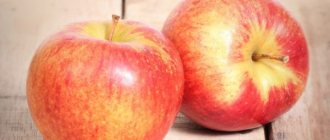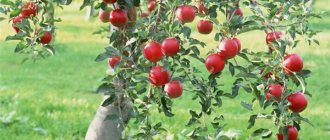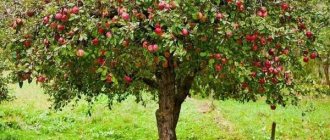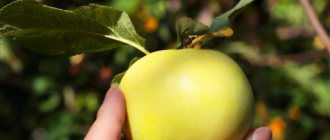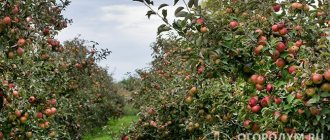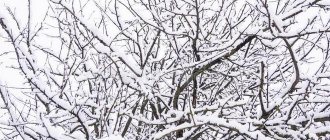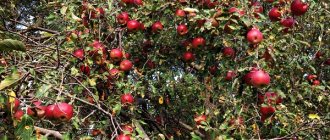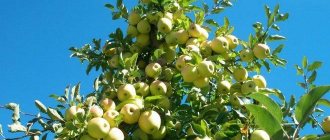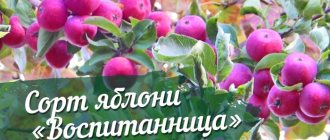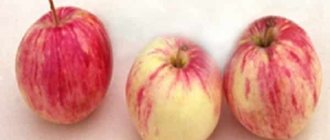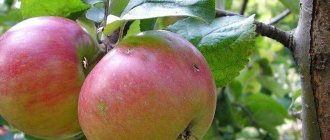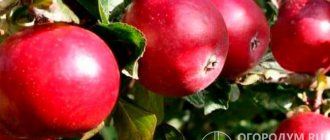Having received a summer cottage, I had no doubt that there would be apple trees in the garden . And, of course, White filling, Semerenko, Calvil snowy. These are the varieties that I knew before serving in the army.
More than 20 years have passed... I began to select varieties. And I especially wanted Seven. And the knowledgeable market convinced me that this variety is a thing of the past.
Here, take Jonagold. And the taste of Jonathan and Semerenko. And took. And he raised it. And the whole family, and not only, admires this taste. Especially last year they were delicious. Semerenko never found the taste of apples. And we are not offended. And we are very pleased with this variety.
Description, photo
- Back in 1943, it was bred by American breeders . You will also find 1968 in publications. Some kind of mistake. Without intent.
- They didn't think for a long time. They adopted the best varieties of apples, Jonathan and Golden Delicious.
- And this happens in life. The child was not very pleased. This is even more common in breeding.
- And they sent it to Europe (Belgium and the Netherlands). Where it was liked and spread successfully.
- Surprisingly. This became an impetus for his popularity in his homeland. In the US it is now one of the 15 most popular apple varieties.
Let's get to know each other in more detail:
- winter apple tree is most likely an early winter tree (it is also called a late autumn tree).
- Vigorous tree.
- From the beginning of fruiting, the shape of the crown transforms from wide-oval to spherical . Largely due to abundant harvests.
- Skeletal branches do not form sharp angles with the trunk. Even closer to a right angle.
- The fruits are round. They may also be slightly elongated.
- And the weight is impressive . Arouses interest among buyers - after all, 250 g is not uncommon. The record holders are the Dutch variety Wilmut with apples of 300 g. And on average – 160-220 g.
- The skin is shiny, elastic and with a waxy coating.
- Sweet and sour taste. Juicy with dense, aromatic, crispy flesh. There is a little bit of astringency.
Jonagold branch with fruits.
What attracts gardeners and specialists:
- High yield;
- Tolerates transportation well;
- Precociousness;
- Long-term storage of fruits;
- And the taste of apples.
Apple tree Jonagold Dacosta
Description of the Jonagold Decosta apple tree:
- Belgium is considered the homeland.
- In the garden where the Jonagold variety was grown, these apples attracted attention with a brighter color - a dark red blush over the entire surface. A little blurry. Sometimes with barely noticeable strokes.
- You will also come across such names - Decosta, Verbeek.
- Perhaps the most famous clone of Jonagold.
Important! Belongs to its fourth group in terms of fruit color.
Same as the main variety:
- Height, crown of a medium-sized tree.
- The fruits are round in shape.
- Weight reaches 170-210 g.
- Disease resistance indicators: To scab – average.
- To powdery mildew – low.
Apple Jonagold Decosta.
What makes them different:
- Ripening time is a week earlier.
- Winter hardiness is slightly higher.
Look at the video of what the Jonagold Decosta apple tree looks like:
The emergence and distribution of the Jonagold variety
The Jonagold apple tree variety was obtained in the mid-twentieth century, in 1943, in the USA. It was bred by scientists at the Geneva breeding station in New York State, crossing the then well-known Jonathan and Golden Delicious varieties. For some reason, the variety did not become widespread in America and in 1960, after some tests, it was brought to Europe. Soon the first industrial plantations of Jonagold appeared in Holland and Belgium. European gardeners were pleased with the new plant and plantings of the variety began to spread to other countries.
In the Soviet Union, Jonagold drew attention in the early 70s, and then serious variety testing began. Around then, this apple tree returned to the American continent and became one of the most popular there. The main work with the variety was carried out in institutes of the steppe and forest-steppe zones of Ukraine, where the emphasis was on determining the frost and drought resistance of the plant. The Jonagold apple tree performed well, and by the mid-80s, seedlings were propagated and brought for planting to different regions of the USSR. It is in our country that the variety has become most widespread and is successfully grown to this day (though only on private plots).
Photo gallery: Jonagold and parents
Golden Delicious variety - fragrant apples of light yellow color
Variety Jonagold - parents can be proud of this offspring
The Jonathan variety is popular due to its unpretentiousness and high yield.
Reviews
Alla Vladimirovna. “We have been eating Jonagold apples for three years now. We enjoy ourselves. Friends like it no less. Excellent winter apples. Semerenko and Calville don’t have their own snow apples. But we didn’t even feel their absence. At least they are popular in the family. Jonagold turned out to be quite enough.”
Nikolai. Shales. “A dozen years ago, on the advice of friends, I planted the Jonagold Decosta apple tree. Of course, I looked at the photo and description of the variety before this. They immediately advised: treat diseases systematically. Also, make sure to water well in the winter. I laid an irrigation hose under the tree for about half an hour. And we are very pleased with the apples. Our Decosta, as we call it.”
Your own. “I purchased this variety as a replacement for the Semerenko apple tree. Although there was no sense of it in the name of this variety. And for several seasons he did not delight us. After all, there were more beloved Idared and Golden Delicious. And these apples were more surprising in size. I missed treatment for scab at one time. And the appearance of the apples was not the best. After 2-3 years of targeted treatment with fungicides (urea and copper sulfate), we eat completely different apples. And we like them even more. And the photo below is from our garden.”
My apple tree Jonagod.
Harvest and storage
Ripe Jonagold apples begin to be picked from the tree in the second half of September, and they reach consumer maturity only in January during storage.
Basic recommendations for harvesting and storing the crop are as follows:
- fruits must be collected by hand, protecting them from mechanical damage;
- It is recommended to collect fruits in dry weather;
- Only apples with smooth skin without damaged or rotten areas are suitable for storage;
- each fruit is wrapped in a layer of paper and placed in prepared wooden or plastic containers with the stalks facing up;
- in a dark and cool basement at an air temperature of about +5°C, the shelf life of fruit is 4–5 months;
- Apples can be stored in the refrigerator for up to 7–8 months at a temperature of +2…+3°C.
During long-term storage, the fruits of this variety become less tasty and juicy, so Jonagold apples are eaten only during the first months after harvest. It is recommended to process the remaining fruits into juices, fruit purees and canned products.
The Jonagold apple tree can please the gardener with a generous harvest of tasty and healthy fruits that are highly transportable and have excellent shelf life. To grow a beautiful and consistently fruit-bearing tree, it is enough to adhere to the listed care recommendations and promptly combat diseases and pests.
Landing
Deadlines
Spring:
- Or at the end of April.
- Or at the beginning of May.
Monitor the condition of the seedlings. So that the roots do not dry out.
Autumn - until frost. When the leaves fall. Gardeners prefer autumn planting . And the Jonagold apple tree variety confirms this in practice. With its adaptability.
Technology
The Jonagold apple tree does not require special conditions when planting. Soils are not heavy (loamy and sandy loam).
Apple tree planting diagram.
As usual, prepare a planting hole for each apple tree:
- The width is 1 m. And you need to dig to a depth of about 1 m.
- Make a small drainage and lay a layer of fertile soil.
- Add compost and fertilizers - mineral and organic.
- Spread the roots of the seedling on the mound.
- Place a stake and secure the seedling.
- After filling with soil, lightly compact the soil with your foot and water generously.
- Mulch well after the soil has settled.
Watch the video on how to prepare a hole for planting:
Advice! Monitor the grafting site (8-10 cm from ground level).
Distance
The distance will be determined by the selected rootstocks:
- On a dwarf - 2.0-2.5 m in a row and 3.5-4.0 m - row spacing;
- On semi-dwarf - 3.0 m and 4.0-4.5 m;
- On vigorous plants - 3.5-4.0 m and 4.5-5.0 m.
And consider the shape of the crown.
Care
The tree needs to be properly cared for.
During the first year, the seedling will need proper and regular watering, as well as pruning and shaping the crown. They begin to fertilize the apple tree only in the 2-3rd year from planting. Mulching the soil around the tree trunk is also of great importance for a young tree. Usually, vermicompost or dry rotted manure is used for this.
Watering
The first watering during planting is the most important stage for a young seedling. It provides the plant with moisture and accelerates soil shrinkage. Be sure to use a watering can.
Overwatering is harmful: it contributes to the appearance of a crust around the roots. Blocking the access of oxygen.
Important! It is better to water a young apple tree in the evening after sunset. The tree will not need to spend energy on photosynthesis; it will use it to absorb nutrients from the soil and grow small roots.
Top dressing
The first year the Jonagold apple tree is not fertilized. Fertilizing begins from 2-3 years of plant life.
The first time was in April. Organic matter is added under the roots: 5-6 buckets of humus are mixed with a kilogram of urea and scattered around the trunk. This also includes mulching the soil.
The second is before flowering, in May. In a 200-liter barrel, dilute 800 g of potassium sulfate, 1 kg of superphosphate and 250 g of the drug Effecton. The solution is stirred and left to infuse for a week. One tree requires 40-45 l..
Important! Before applying liquid fertilizer, water the tree with plain water so as not to burn the roots. They retreat half a meter from the trunk.
The third fertilizing is applied in the summer, when the fruits begin to fill. At this time, a nutrient solution is also prepared in advance. For 200 liters of water, take 1 kg of nitrophoska and 20 g of sodium humate, stir and leave for several days. Before applying, also water the apple tree with water. The solution consumption is 30-35 liters for each tree.
The fourth feeding occurs in the fall, when the harvest has already been harvested. At this time, it is better to add dry complexes: superphosphate and potassium sulfate. They are simply scattered around the tree, 300 g each. In dry autumn, fertilizers are dissolved in water and applied after watering.
For apple trees, not only root, but also foliar feeding is useful.
Leaves, trunk and skeletal branches are moistened with urea solution (2 tbsp per bucket of water). The first time is sprayed before flowering, the second time after (the interval is 20 days).
Cleaning blood vessels with garlic: Tibetan recipe, tincture with lemon in vodka, alcohol
This substance serves not only as a top dressing, but also as a means against pests on the leaves, bark and in the tree trunk.
Also suitable is the Kemira preparation, which contains all the microelements necessary for a tree: manganese, zinc, copper, magnesium, boron, molybdenum and others. Foliage and branches are sprayed twice with an interval of 2 weeks during the period of fruit ripening.
Features of ripening and fruiting
Beginning of fruiting
Starts after 2-3 years . And then annually and progressively.
In outskirts of Moscow
It is determined by the climate chosen by the rootstock. Adjust the timing of flowering and ripening. They will be a little later.
In the Moscow region, Jonagold begins to bear fruit a little later.
Deadlines
Fruit ripening
In September (closer to October), you definitely need to store apples - yellow-orange with a bright pink blush. And some even seem greenish. So you don’t have to eat them right away. This is removable maturity.
Jonagold apples after removal.
But in January it’s a different taste. The taste of a ripe apple!
Fruit storage
- In the refrigerator at a temperature of 2-3 degrees - until April.
- If the storage temperature is higher, even less.
Pruning and crown formation
The tree needs pruning twice a year. The procedure will require sharp and disinfected instruments - pruning shears and a hacksaw.
The cuts should be even, the wounds should be treated with garden varnish. Old branches are lubricated immediately after the procedure, young ones - only after 15-20 hours.
In spring, pruning is needed to stimulate vegetation and increase yield. The crown needs to be thinned out so that it is better warmed by the sun and there is an influx of fresh air. First of all, branches growing inward or parallel to skeletal shoots are removed. Then the twigs growing on the trunk or branches are removed.
In autumn, the procedure is carried out in October-November, when the movement of sap along the trunk stops. The shoots that have grown over the summer are shortened by a third to stimulate their growth next year. Broken shoots, growing inwards and simply weak shoots are also removed.
For pruning, choose a cloudy, windless day, without precipitation or sudden temperature changes.
Subspecies and options
Semi-dwarf
MM-106 rootstocks enable your tree to more successfully resist diseases, frosts and drought:
- It begins to bear fruit earlier. Even for the 2-3rd year.
- It will take up to 25-35 years to bear fruit and produce good apples (up to 100 kg per tree).
- Apples are no worse than on other rootstocks.
Dwarf
Its nuances:
- The height is even less - 2.5-3.5 m . Same as the crown.
- But it lives and bears fruit for up to 15-20 years.
King
- Weak-growing spur.
- Solid light red color of the fruit.
Fruits of Jonagold King.
- Increased resistance: to diseases (scab and powdery mildew, including).
- to frost.
Advice! On weak-growing rootstocks, the original formations are better - spindle, fruit wall.
Morrens
The most famous and popular of the clones of the Jonagold variety. You will meet the names - Jonagored, Highlander. Aka Jonagored Morrens Supra:
- The variety was not bred, but was discovered (or noticed) in 1980 in Belgium (spontaneous mutation).
- And in 1989 he was already awarded a gold medal in England. After all, even tasters (and they are strict people) give it scores from 4.6 to 5 points.
- And weight 170-220 g.
Apple tree Jonagold Morrens.
- Ripens in the first half of October. And you can store it for up to 7 months.
- Fruits in any weather.
- And the indicators for resistance to frost and disease are higher than those of their predecessors.
Attention! It is still one of the ten best apples in the world.
You can see what the Jonagored Morrens Supra apple tree looks like in the video below:
Diseases and pests
The variety has weak immunity to fungal diseases. It may be affected by:
- scab, the symptoms of which are olive spots on the leaves and fruits, as a result of which the fruit begins to crack. The disease can be prevented by treating apple trees in early spring with a 1% solution of Bordeaux mixture (100 g of copper sulfate and 150 g of lime per 10 liters of water). At the end of May, trees must be sprayed with the fungicide Fitosporin-M;
- powdery mildew, the occurrence of which is characterized by the appearance of a white coating on the buds and buds. Prevention from the disease is to treat trees with Bordeaux mixture, and when the first symptoms occur, apple trees must be treated with colloidal sulfur or Topaz fungicide;
- moniliosis, manifested by brown spots on the fruits, which over time cover their entire surface. The fruits shrink and become inedible. To avoid disease, apple trees are sprayed in the spring with a 1% solution of Bordeaux mixture.
Scab on an apple tree.
Trees of the Jonagold variety may be subject to attacks by apple moth, codling moth and hawthorn, from which they will be protected by treatment with insecticides Iskra, Aktara, Karbofos, etc.
Features of cultivation in the regions
In outskirts of Moscow
If you really want to grow Jonagold varieties:
- Select on frost-resistant, zoned rootstocks.
- And the most winter-hardy. The same Jonagored Morens. And Jonagold Decosta.
Timely agricultural technology will protect against frost and maintain good yields. The use of copper-containing fungicides is included in these measures.
In Ukraine
In the gardens of scientific institutions of Ukraine in the steppe and forest-steppe zone:
- Since the beginning of the seventies, initial tests of this variety have been carried out.
- Since the mid-eighties - extensive production tests.
The Jonagold apple tree is successfully grown in Ukraine.
And in our time - one of the most popular varieties among amateur gardeners. So do farmers.
In Belarus
In northern Polesie, as in Belarus, it can be grown on winter-hardy rootstocks.
Advantages and disadvantages
The Jonagold variety is characterized by many advantages:
- high taste and presentable presentation;
- generous yield;
- early fruiting periods;
- duration of storage and possibility of transportation;
- versatility of use.
The disadvantages are considered:
- low winter hardiness;
- poor immunity to disease.
Apple tree Jonathan: description of the variety
Apple tree Jonathan: photo of variety
- Description of the tree
Jonathan apple trees are not overly gigantic in size. In fact, if grown in our area, they are relatively medium-sized.
But as for the branches, they are very different in length from each other in the Jonathan apple tree variety, especially the skeletal ones, which is usually not typical for medium-sized apple trees. It should also be noted that they most often do not depart from the trunk at an acute angle.
Thanks to such unusual properties of the skeletal branches of the tree, the entire crown has a rather unusual and unusual shape. It is difficult to describe as any kind of geometric figure, but over time, when the branches are more or less aligned, it becomes relatively similar to a ball.
The bark of the Jonathan apple tree has a slightly brownish tint. You can also notice small splashes of white and green on it. By the way, it definitely won’t be possible to call it smooth, since even young plants form small folds on the bark.
Speaking about the fruiting of a tree, it should be noted that an apple can grow almost any shoot on itself: both old and annual, and therefore they are all necessary and important.
Like the branches, by the way, the shoots most often grow uneven and unequal. However, this in no way makes the tree worse, since they are still very strong and powerful, which allows them to easily support the weight of the apples.
By the way, the Jonathan apple tree variety has another distinctive feature, thanks to which I determined that it was this variety that was missing from my father’s collection: the leaves of the Jonathan apple tree always have a thin silvery coating, which not all trees have.
As for the other characteristics of the leaves of this tree, they are still quite standard: the leaves are quite small, have a matte surface, an oval shape, and are pointed at both ends.
- Description of fruits
The Jonathan apple tree begins to bloom in May. At the same time, the Jonathan apple tree is considered medium-late, which means that its fruits ripen a little later than the average varieties, but also earlier than the late ones.
The apple trees themselves are incredibly beautiful, tasty and juicy, which is why this variety, of course, is loved by gardeners almost all over the world.
In appearance, they have an almost perfect spherical shape, making it simply pleasant to look at a tree with fruits. However, the shape, of course, has slight flattening at the bottom and top, but they are not critical.
The color of the apple trees itself is incredibly rich red, and on its surface you can see small contrasting green stripes, which make the appearance of the plant even more interesting and unusual.
Well, of course, you are interested to know what taste the fruits of the Jonathan apple tree have. Those who have tried apples of this type claim that they are simply wonderful: they have a creamy-sweet taste, but are not overly sugary.
A small touch of sourness brings balance to the flavor palette, which makes the taste of Jonathan apples truly exquisite. Some even note that subtle wine notes can be detected in them.
Region of natural growth
The variety does not tolerate prolonged frosts well, so it is not suitable for growing in cold climates with extreme frosts.
Jonagold is a moderately drought-resistant that feels comfortable in temperate and warm climates, where it takes root well and produces maximum yield.
Also suitable for planting in regions with a temperate climate are the following varieties: Augusta, Papirovka, Malinovka, Yandykovsky and Quinti.
Characteristics of the variety
There are more than 100 species that share characteristics with this apple tree. Such varieties may differ in external features and taste.
Description of the tree and fruits
The crown of an apple tree has an oval shape in the initial stages of tree development, but over the years it begins to press against the edges, forming a round shape. The branches grow wide, occupying a large space.
Although the buds open quite quickly, young shoots appear slowly. Fruits that appear no earlier than 1 year after planting usually form ovaries on twigs and growths.
If trees are planted on frost-resistant seedlings, they can live up to 35 years, and if they are planted on stilts of medium height, they can live up to 25 years.
The apples of this variety are quite large and weigh from 150 to 250 g. The description says that their shape is round, but sometimes there are fruits that are slightly flattened on both sides, with roughness in the calyx area. The peel of the fruit is of medium thickness and has a sweetish taste.
The calorie content of an apple is 45 kcal per 100 g. Its nutritional value has the following characteristics:
- carbohydrates – 12 g;
- fats – 0.5 g;
- proteins – 0.5 g.
Sometimes the fruit is covered with a kind of rusty mesh. The pulp of the fruit has a light yellow tint and a dense structure, and its aroma attracts with its sweetness. Often the color of the apple is yellow-green with a red blush on the sides and closer to the stem. The pulp has a sweet and sour aftertaste with varying degrees of astringency.
Productivity
The first harvest can be carried out already 2-3 years after planting the tree. On average, during the first 10 years it can produce 15 kg of apples per year of fruiting. Subsequently, about 60 kg of crops are harvested from one tree each season. The apples ripen in mid-September, when a purple tint appears on their sides.
Pollinators and clones
Apples may vary in appearance
Breeders have bred a huge number of clones of this variety. Among them, these varieties stand out:
- fruits with a smoothly stretched red crimson over the entire surface - Rubin-Star, Jomured;
- apples with a bright red, slightly blurred color - King Jonagold, Jonica;
- varieties with dark crimson colors, on which stripes are sometimes visible - Jonagold Decosta, Jonagored;
- fruits whose color varies from the lightest to the darkest are Novayo;
- fruits of bright colors with clear lines - Wilmut.
It is recommended to plant several pollinator trees next to the Jonagold apple tree. The most suitable varieties are Champion, Jonathan, Idared, Melrose, etc.
Frost resistance
The apple tree variety is often classified as an early winter variety, because Harvest at the end of September. If stored properly, the fruits may not lose their taste until mid-spring. It is recommended to grow the tree in regions with moderately cold winters, because... Low temperature changes are dangerous for him.
Resistance to diseases and pests
The Jonagold apple tree can easily tolerate diseases and pests when special products and solutions are applied. The description suggests that most often the crop is affected by scab, but this variety is resistant to it.
Frequent pests of trees such as apple trees are codling moths, apple moths, silkworms, etc. Powdery mildew is one of the main enemies of the crop, because signs of this disease can appear at any time of the year. This disease is known for causing white spots on foliage (fungal spores).
If no action is taken, the spots darken and spread throughout the tree: to the shoots and fruits. In the spring, the shoots must be treated with Bordeaux solution. During the period when the buds begin to bloom, it is recommended to spray the tree with products containing a high copper content.
Growing regions
The regions for cultivating this apple variety are quite diverse and occupy large areas with moderately cold winters. Such places have a predominantly temperate and warm climate. You can grow apple trees in Ukraine, Belarus, America, and in the central and southern parts of Russia.
Species diversity
With various crossings of trees, quite popular varieties of the Jonagold apple tree were developed:
- King. The fruits are yellow with red splashes. It has high resistance to diseases and frost. In terms of their structure, these are low-growing trees with apples weighing 150 g;
- Morens is the most popular variety of the variety, with high tasting scores - up to 5 points. The fruits weigh up to 230 g and are stored for up to 7 months from October. The fruits are resistant to low temperatures and have good immunity.
What type does it belong to?
The Jonagold apple tree is a winter variety.
The crossed variety quickly became in demand for its taste, high level of fruiting and long-lasting shelf life of apples.
Read also: Sun-dried tomatoes in oil Italian recipe
Jonagold apples have a calorie content of 45 kcal.
Jonagold is harvested in late September - early October.
Apples are stored until February, in the refrigerator until April.
Apple tree Jonathan: variety care
Apple tree Jonathan: photo of variety
You understand perfectly well that, despite the fact that planting is indeed one of the most important procedures in the life of any plant, it still needs to be closely monitored after planting, as well as well cared for.
This is precisely what a set of procedures is aimed at, such as watering, fertilizing, preventive spraying or, for example, mulching, the purpose of which is precisely to protect the plant from all sorts of incidents that may occur as it grows, as well as to provide it with nutrients.
I especially want to draw your attention to mulching, since it is this procedure that can incredibly simplify your life. Not only does it prevent moisture from the soil from leaving it, but it also protects the plant from all sorts of weeds that constantly try to prevent you from growing a wonderful apple tree.
It is advisable to change the mulch after absolutely every watering, but it may well last longer - it all depends on the quality of the mulching material.
- Trimming
However, we decided to highlight this procedure as a separate item, since it is as important as it is complex, and therefore you simply must know exactly how to prune in order to make the tree look better.
First of all, it should be noted that many gardeners recommend pruning in the first year of a seedling’s life - right when you purchase it. However, I think a little differently, since first you need to observe which branches can grow well without your participation, and which ones need special care. And if you do the pruning right away, you won’t know for sure.
Therefore, I strongly recommend carrying out the first pruning exclusively in the second year, and also dividing it into several stages:
For formative pruning, which is incredibly important at the beginning of the seedling’s growth, but will no longer be necessary later.
For sanitary pruning, which must be carried out at the beginning of each growing season in order to get rid of old, diseased and damaged branches.
For rejuvenating, which is relevant exclusively for mature apple trees and only serves to obtain more abundant harvests.
The most difficult of them all, in my opinion, is the formative one, since it is associated with a very serious choice: what exact shape should the crown of your apple tree have.
There are a huge number of them, and each has its adherents. However, you will have to weigh the pros and cons and choose the crown shape that is right for you.
As for all the other prunings, they are not particularly difficult: the main thing is to identify in time which branches need to be removed and remove them directly.
Important! You must understand that pruning is a procedure that involves direct intentional harm to the plant, and therefore it must be carried out with extreme caution, and only with good tools.
- Timing of pruning
In fact, determining exactly when pruning should be done will not be difficult, since for the most part the timing of this procedure coincides with other important dates in the life of the plant.
Sanitary pruning, as already mentioned, is carried out exclusively in the spring - when the tree has come out of hibernation. In this case, you will have to wait until all return frosts have passed, since otherwise the tree will not be able to grow normally.
In the summer, formative pruning is carried out, which includes the formation of the correct shape of the crown.
- Jonathan apple tree pollinators
In fact, when it comes to the fact that the Jonathan apple tree is a self-fertile variety, I write this down as a negative for the plant, since along with it you will also have to plant another variety that you may not be so interested in.
However, when describing the disadvantages of the Jonathan apple tree, I did not mention the need for a pollinator. Why not?
The fact is that this tree is partially self-pollinating. However, if you are satisfied with exceptionally record harvests, then you will still have to resort to the “services” of pollinator varieties.
Gardeners who have worked with the Jonathan apple tree claim that the following apple trees are best suited as pollinators:
- Golden Delicious
- Idared
- Mac
- Welsey
- Melba
Thanks to these varieties, you will be able to significantly increase the number of apples. If we talk about more specific figures, we can note that without the presence of pollinators, Jonathan’s fruits are set exclusively on a third of all flowers, but with pollinators the percentage jumps to eighty and even almost ninety.
